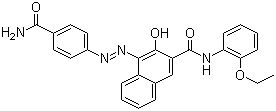Pigment Red 170
| Product Name | PIGMENT RED 170 |
| Synonyms | C.I.Pigment Red 170; C.I.PR170; PR170; P.R.170 |
| C.I. | 12475 |
| CAS NO. | 2786-76-7 |
| EINECS | 220-509-3 |
| Molecular Weight | 454.48 |
| Molecular Formula | C26H22N4O4 |
| Color | Red powder |
![]()
Molecular structure formula:

Fastness Properties of Pigment Red 170:
| Light Fastness | 5 |
| Heat Resistance(℃) | 180 |
| Water Resistance | 5 |
| Oil Resistance | 4 |
| Acid Resistance | 5 |
| Alkali Resistance | 5 |
| Alcohol Resistance | 4-5 |
Main application: Water based ink, Offset ink, Solvent based ink, Plastic, Paint, Textile printing
We have various pigment grades and properties to meet different customers’ needs, please specify your application and requirements so that we can recommend accordingly. E-mail: sy@sypigment.com
Product Description of Pigment Red 170:
Pigment Red 170 has stronger than Pigment Red 210, it is a neutral red color and has two crystal forms; the transparent type is blue-red and has a light fastness of level 6, and the non-transparent type has a light fastness of level 7, high hiding power and more stable to solvents; Novoperm Red F2RK The specific surface area of 70 is 23m2/g; it is mainly used in coatings, and can be mixed with molybdenum chrome orange and quinacridone.Mainly used in coatings and solvent printing inks, water-based printing inks, textile printing and dyeing, etc.
Pigment red 170 or PR170 is an organic pigment extensively used in automotive coatings and painting.
It is produced synthetically by converting p-aminobenzamide into the corresponding diazonium compound followed by coupling with 3-hydroxy-2-naphththoic acid (2-ethoxy)anilide ("Naphtol AS-PH" dye precursor).
In the solid state the hydrazo tautomer forms and several crystal structures exist. In the initial α polymorph the molecules are arranged in a herringbone pattern with extensive hydrogen bonding. The φ polymorph is more dense and more stable and produced industrially by thermal treatment in water at 130°C under pressure. In this phase the molecules are planar and arranged in layers. Extensive hydrogen bonding exists within the layer but between layers the only interactions are Van der Waals forces. Dense crystal structures are preferred for pigments used in coatings because in the event of photochemical decomposition the fragments are locked in place and are able to recombine. Research shows that by replacing the ethoxy group in this compound by a methoxy group the crystal structure is less stable and in the final application and the color fades more easily. By careful selection of substituents it is possible to optimize crystal structure and improve optical properties.
TDS (Pigment Red 170) MSDS (Pigment Red 170)Synonyms
- C.I. Pigment Red 170
- 2786-76-7
- PIGMENT RED 170
- UNII-54O6PK8790
- 54O6PK8790
- 4-[(4-carbamoylphenyl)diazenyl]-N-(2-ethoxyphenyl)-3-hydroxynaphthalene-2-carboxamide
- 4-[[4-(Aminocarbonyl)phenyl]azo]-N-(2-ethoxyphenyl)-3-hydroxynaphthalene-2-carboxamide
- CI Pigment Red 170
- 2-Naphthalenecarboxamide, 4-((4-(aminocarbonyl)phenyl)azo)-N-(2-ethoxyphenyl)-3-hydroxy-
- 2-Naphthalenecarboxamide, 4-[[4-(aminocarbonyl)phenyl]azo]-N-(2-ethoxyphenyl)-3-hydroxy-
- 4-4-(Aminocarbonyl)phenylazo-N-(2-ethoxyphenyl)-3-hydroxynaphthalene-2-carboxamide
- Permanent Red F 5RK
- Permanent Red F 3RK70
- C.I. Pigment Red 120
- HSDB 3901
- 4-((4-(Aminocarbonyl)phenyl)azo)-N-(2-ethoxyphenyl)-3-hydroxynaphthalene-2-carboxamide
- EINECS 220-509-3
- EC 220-509-3
- SCHEMBL2139449
- DTXSID7029243
- SCHEMBL12954916
- SCHEMBL14560976
- SCHEMBL16191196
- SCHEMBL21468586
- P.R.266F7RK
- 2-Naphtho-o-phenetidide, 4-((p-carbamoylphenyl)azo)-3-hydroxy-
- ZINC33839056
- ZINC100048551
- 4-((4-(Aminocarbonyl)phenyl)azo)-N-(2-ethoxyphenyl)-3-hydroxy-2-naphthalenecarboxamide
- C.I.12475
- 071N997
- W-109137
- Q15425799
- 2-Naphthalene-carboxamide,3-hydroxy-4-(((4-aminocarbonyl)phenyl)azo)-N-(2-ethoxyphenyl)-
- 3-(2-Ethoxyphenylcarbamoyl)-1-[2-(4-carbamoylphenyl)hydrazono]naphthalene-2(1H)-one
- 4-[(E)-(4-carbamoylphenyl)diazenyl]-N-(2-ethoxyphenyl)-3-hydroxy-2-naphthamide
- 2-Naphthalenecarboxamide, 4-(2-(4-(aminocarbonyl)phenyl)diazenyl)-N-(2-ethoxyphenyl)-3-hydroxy-
IUPAC Name: 4-[(4-carbamoylphenyl)diazenyl]-N-(2-ethoxyphenyl)-3-hydroxynaphthalene-2-carboxamide
InChI: InChI=1S/C26H22N4O4/c1-2-34-22-10-6-5-9-21(22)28-26(33)20-15-17-7-3-4-8-19(17)23(24(20)31)30-29-18-13-11-16(12-14-18)25(27)32/h3-15,31H,2H2,1H3,(H2,27,32)(H,28,33)
InChIKey: BGVYDWVAGZBEMJ-UHFFFAOYSA-N
Canonical SMILES: CCOC1=CC=CC=C1NC(=O)C2=CC3=CC=CC=C3C(=C2O)N=NC4=CC=C(C=C4)C(=O)N
| Property Name | Property Value |
| Molecular Weight | 454.5 |
| XLogP3-AA | 5.2 |
| Hydrogen Bond Donor Count | 3 |
| Hydrogen Bond Acceptor Count | 6 |
| Rotatable Bond Count | 7 |
| Exact Mass | 454.1641052 |
| Monoisotopic Mass | 454.1641052 |
| Topological Polar Surface Area | 126 Ų |
| Heavy Atom Count | 34 |
| Formal Charge | 0 |
| Complexity | 724 |
| Isotope Atom Count | 0 |
| Defined Atom Stereocenter Count | 0 |
| Undefined Atom Stereocenter Count | 0 |
| Defined Bond Stereocenter Count | 0 |
| Undefined Bond Stereocenter Count | 0 |
| Covalently-Bonded Unit Count | 1 |
| Compound Is Canonicalized | Yes |



